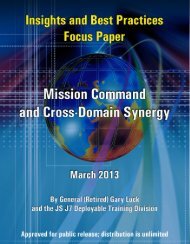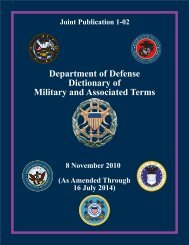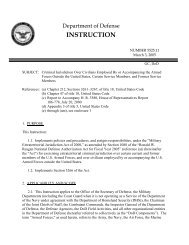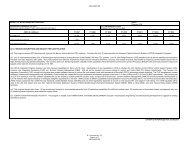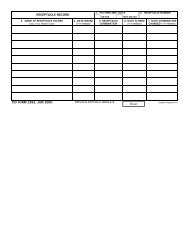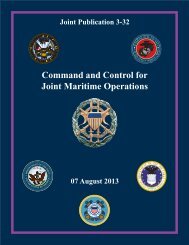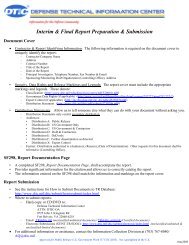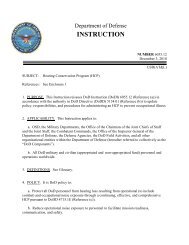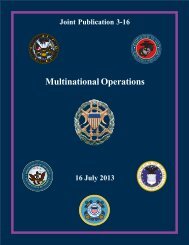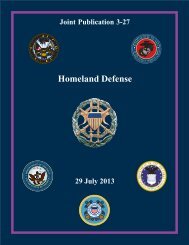JP 1, Doctrine for the Armed Forces of the United States - Defense ...
JP 1, Doctrine for the Armed Forces of the United States - Defense ...
JP 1, Doctrine for the Armed Forces of the United States - Defense ...
You also want an ePaper? Increase the reach of your titles
YUMPU automatically turns print PDFs into web optimized ePapers that Google loves.
Theory and Foundations<br />
attack; passive defensive measures that make friendly <strong>for</strong>ces, systems, and facilities difficult<br />
to locate, strike, and destroy; technology and procedures that reduce <strong>the</strong> risk <strong>of</strong> fratricide;<br />
and emergency management and response to reduce <strong>the</strong> loss <strong>of</strong> personnel and capabilities<br />
due to accidents, health threats, and natural disasters. When directed, <strong>the</strong> JFC’s mission <strong>for</strong><br />
protection may extend beyond <strong>for</strong>ce protection to encompass protection <strong>of</strong> US civilians; <strong>the</strong><br />
<strong>for</strong>ces, systems, and civil infrastructure <strong>of</strong> friendly nations; and our interorganizational<br />
partners.<br />
(6) Sustainment is <strong>the</strong> provision <strong>of</strong> logistics and personnel services necessary to<br />
maintain and prolong operations until mission accomplishment. Sustainment provides <strong>the</strong><br />
JFC flexibility, endurance, and <strong>the</strong> ability to extend operational reach. Effective sustainment<br />
determines <strong>the</strong> depth to which <strong>the</strong> joint <strong>for</strong>ce can conduct decisive operations, allowing <strong>the</strong><br />
JFC to seize, retain, and exploit <strong>the</strong> initiative.<br />
d. Joint functions should be balanced and integrated with due consideration <strong>of</strong><br />
competing resources, multiple versus single support capabilities, shifting operational<br />
priorities, and differences among Service component practices.<br />
For a more detailed discussion <strong>of</strong> joint functions, refer to <strong>JP</strong> 3-0, Joint Operations.<br />
12. Joint Operation Planning<br />
a. Joint operation planning is <strong>the</strong> way <strong>the</strong> military links and trans<strong>for</strong>ms national<br />
strategic objectives into tactical actions. It ties <strong>the</strong> military instrument <strong>of</strong> national power to<br />
<strong>the</strong> achievement <strong>of</strong> national security goals and objectives and is essential in promoting and<br />
securing desired global strategic end states during peacetime and war. Planning begins with<br />
<strong>the</strong> end state in mind, providing a unifying purpose around which actions and resources are<br />
focused.<br />
b. Joint operation planning provides a common basis <strong>for</strong> discussion, understanding, and<br />
change <strong>for</strong> <strong>the</strong> joint <strong>for</strong>ce, its subordinate and higher headquarters, <strong>the</strong> joint planning and<br />
execution community (<strong>JP</strong>EC), and <strong>the</strong> national leadership. In accordance with <strong>the</strong> Guidance<br />
<strong>for</strong> Employment <strong>of</strong> <strong>the</strong> Force (GEF), adaptive planning supports <strong>the</strong> transition <strong>of</strong> DOD<br />
planning from a contingency-centric approach to a strategy-centric approach. The Adaptive<br />
Planning and Execution (APEX) system facilitates iterative dialogue and collaborative<br />
planning between <strong>the</strong> multiple echelons <strong>of</strong> command. The APEX system ensures that <strong>the</strong><br />
military instrument <strong>of</strong> national power is employed in accordance with national priorities and<br />
policy. It also guarantees <strong>the</strong> plans are rapidly updated and adapted as <strong>the</strong> situation requires<br />
according to changes in policy, strategic guidance, resources, and/or <strong>the</strong> operational<br />
environment. Joint operation planning also identifies capabilities outside <strong>of</strong> DOD required<br />
<strong>for</strong> accomplishment <strong>of</strong> strategic end states and objectives and provides a <strong>for</strong>um <strong>for</strong><br />
interagency dialogue, coordination, and action.<br />
c. The pursuit and attainment <strong>of</strong> <strong>the</strong> US national strategic objectives in today’s complex<br />
environment requires critical and creative thinking about <strong>the</strong> challenges facing <strong>the</strong> joint<br />
<strong>for</strong>ce. Joint operation planning fosters understanding, allowing commanders and staff to<br />
clearly understand <strong>the</strong> operational environment and identify <strong>the</strong> problem(s) and problem<br />
I-19



